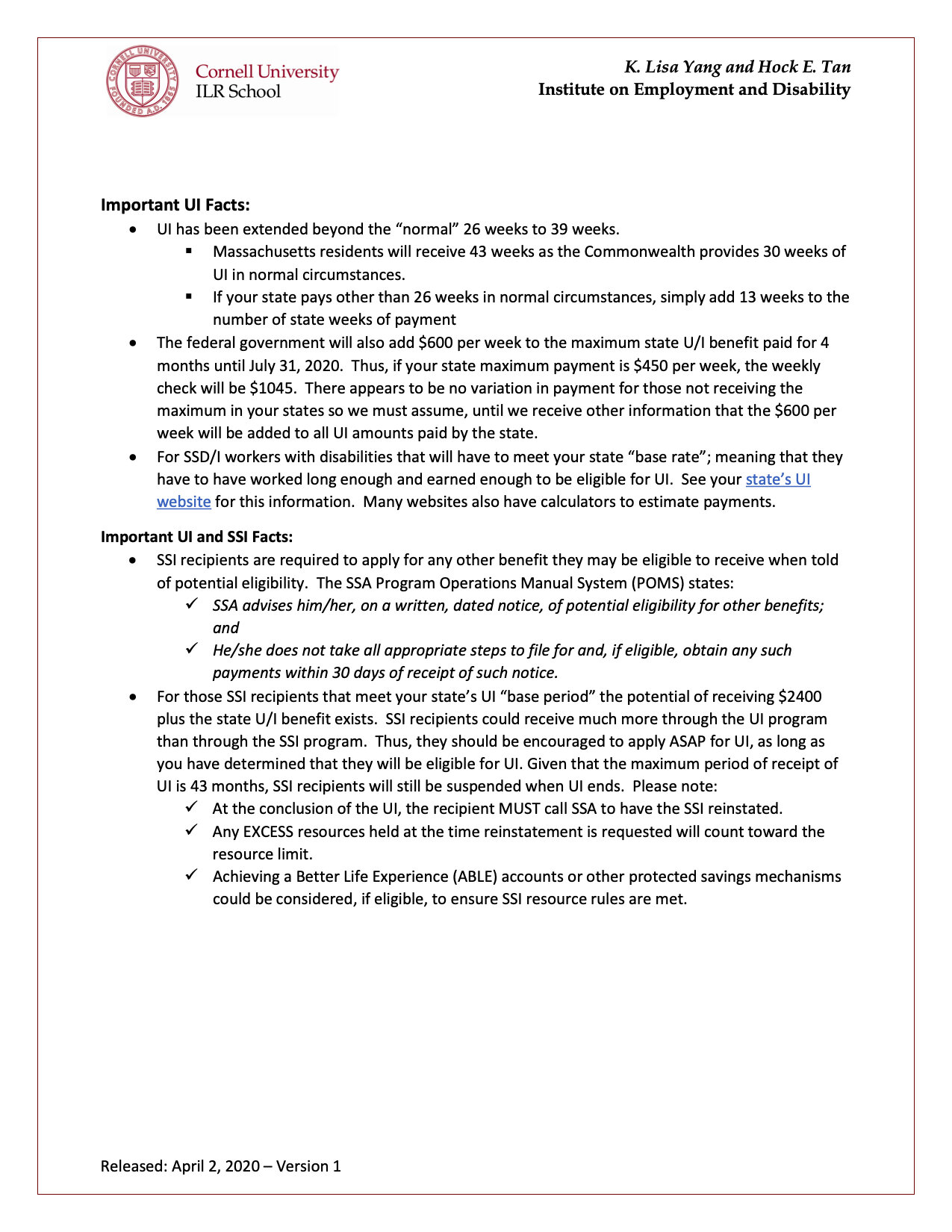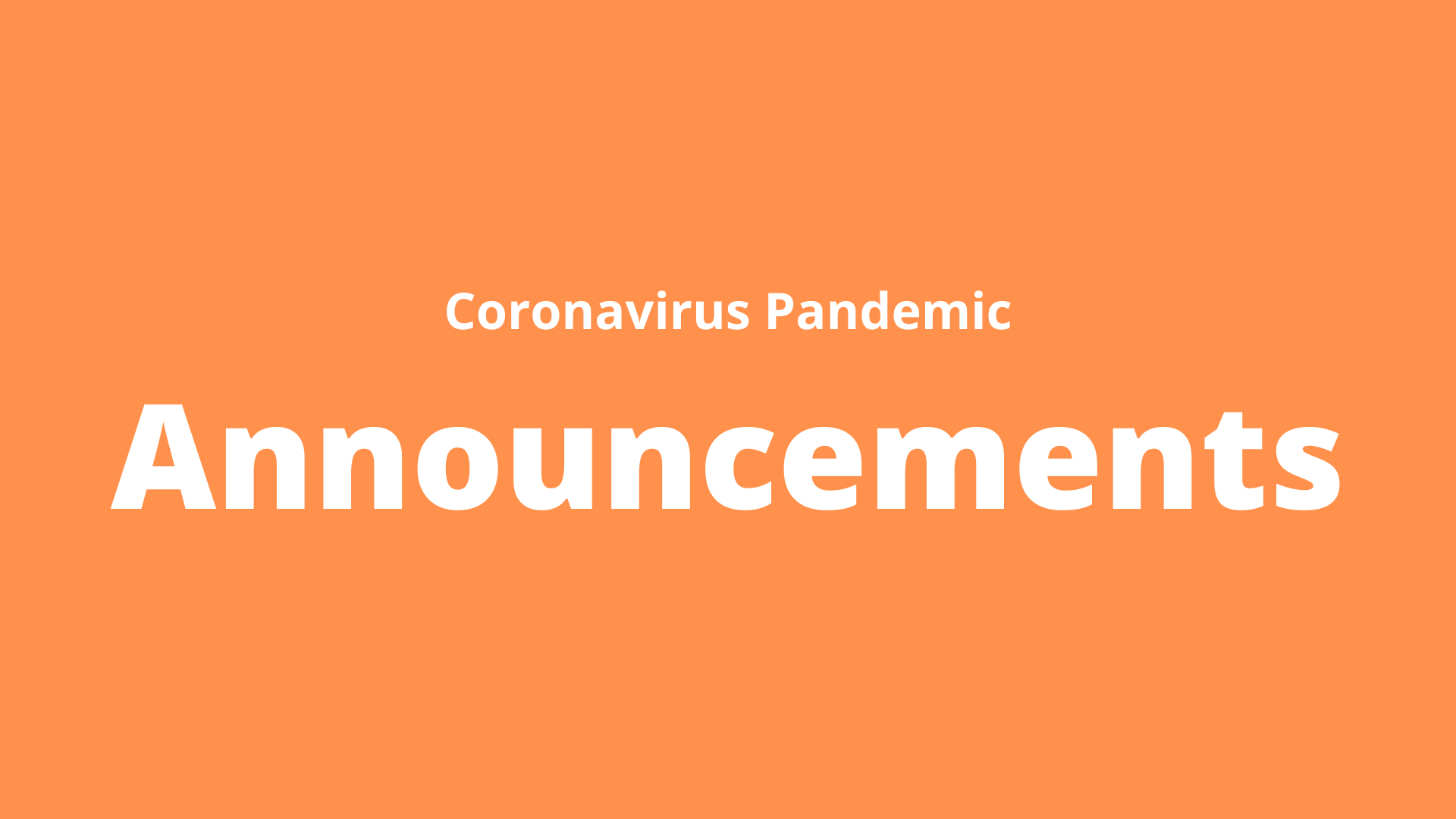Text version:
COVID-19 AND SOCIAL INSURANCE AND BENEFIT PROGRAMS
With ongoing impact of covid-19 still not fully understood by the community at large, individuals with disabilities who regularly access a series of public benefits are left with a variety of questions about the impact of the various federal and state legislative and administrative actions on these various benefits. Key language in the Coronavirus Aid, Relief, and Economic Security Act (CARES Act) serves as a guidepost from which the impact on benefits can be better understood.
Notwithstanding any other provision of law, any refund (or advance payment with respect to a refundable credit) made to any individual under this title shall not be taken into account as income, and shall not be taken into account as resources for a period of 12 months from receipt, for purposes of determining the eligibility of such individual (or any other individual) for benefits or assistance (or the amount or extent of benefits or assistance) under any Federal program or under any State or local program financed in whole or in part with Federal funds. 26 U.S. Code § 6409
Supplemental Security Income (SSI)
Individuals who are receiving SSI need to be aware of several key elements related to the stimulus payment:
1. Stimulus payments are NOT taxable.
2. Stimulus payments received by the individual that are initiated through the Coronavirus Aid, Relief,
and Economic Security Act (CARES Act) will not counts as income in the calculation of the
individual’s SSI amount for that month(26 U.S. Code § 6409).
3. Stimulus payments will not be counted as “resources” for a twelve month period following the
receipt of the funds (26 U.S. Code § 6409).
Social Security Disability Insurance (SSDI), Disabled Widow(er) Benefits (DWB),
Childhood Disability Benefits (CDB)
The stimulus payment will have no impact on any of these Title II benefits: SSDI, DWB, CDB, and SSA Retirement. These benefits are classified as insurance benefits and are NOT impacted by unearned income. In addition, the stimulus payments will NOT be taxable.
Please note that Title II benefits are SSA benefits. SSI benefits are federal welfare benefits. At any time when the Act refers to “Social Security Benefits, “SSI” is not included unless specifically stated by the statute.
Supplemental Nutrition Assistance Program (SNAP)
There is no impact on SNAP benefits due to the receipt of a stimulus payment in accordance with 26 U.S. Code § 6409.
Housing and Urban Development (HUD)
There is no impact on HUD rent subsidies due to the receipt of the stimulus funds. Further, HUD housing does not consider an individual’s resources. Only the income produced by the resource, bank interest, is considered by HUD. *Please check your state rules concerning and state public housing in which an individual may be living.
HUD has also extended a “tailored set of mortgage payment relief options for single family homeowners with FHA-insured mortgages”. “Effective immediately for borrowers with a financial hardship that makes them unable to pay their mortgage due to the COVID-19 National Emergency, mortgage servicers must extend deferred or reduced mortgage payment options - called forbearance - for up to six months, and must provide an additional six months of forbearance if requested by the borrower”1.
Medicaid
In all states that have accepted the Federal Medical Assistance Percentage (FMAP) 6.2% increase from the federal government (only NYS is in question), Medicaid recipients who received benefits before the COVID- 19 crisis, or become eligible during the crisis cannot be terminated from Medicaid.
On a case by case basis, states may change the category or eligibility, e.g., from regular Medicaid to 1619(b) or Medicaid Buy-In for Working People with Disabilities (MBI-WPD), but terminations of coverage will not be allowed.
Medicare
The stimulus payment will have no impact on Medicare premiums or eligibility. Medicare Savings Plans (MSPs), those programs that see Medicaid paying all or part of Medicare premiums for Parts B and D, and in some cases co-pays and deductibles, will also not be impacted by the stimulus payments in accordance with above language (26 U.S. Code § 6409).
Temporary Assistance for Needy Families (TANF)
In accordance with the language in 26 U.S. Code § 6409, the stimulus payment will have no impact on TANF eligibility or resource levels for a 12 month period from receipt of the funds.
Unemployment Insurance (UI)
Each state is responsible for establishing its own UI benefits eligibility. In general, individuals qualify when:
Are unemployed through no fault of your own. In most states, this means you have to have separated from your last job due to a lack of available work.
Meet work and wage requirements. You must meet your state’s requirements for wages earned or time worked during an established period of time referred to as a "base period." In most states, this is usually the first four out of the last five completed calendar quarters before the time that your claim is filed.
Meet any additional state requirements. Find details of your own state’s program.
HUD (2020, April 1). HUD issues new CARES act mortgage payment relief for FHA single family homeowners. HUD https://www.hud.gov/press/press_releases_media_advisories/HUD_No_20_048
DOL (2020, April, 2). How do I file for unemployment insurance? DOL https://www.dol.gov/general/topic/unemployment-insurance
Important UI Facts:
• UI has been extended beyond the “normal” 26 weeks to 39 weeks.
Massachusetts residents will receive 43 weeks as the Commonwealth provides 30 weeks of UI in normal circumstances.
If your state pays other than 26 weeks in normal circumstances, simply add 13 weeks to the number of state weeks of payment
• The federal government will also add $600 per week to the maximum state U/I benefit paid for 4 months until July 31, 2020. Thus, if your state maximum payment is $450 per week, the weekly check will be $1045. There appears to be no variation in payment for those not receiving the maximum in your states so we must assume, until we receive other information that the $600 per week will be added to all UI amounts paid by the state.
• For SSD/I workers with disabilities that will have to meet your state “base rate”; meaning that they have to have worked long enough and earned enough to be eligible for UI. See your state’s UI website for this information. Many websites also have calculators to estimate payments.
Important UI and SSI Facts:
• SSI recipients are required to apply for any other benefit they may be eligible to receive when told of potential eligibility. The SSA Program Operations Manual System (POMS) states:
SSA advises him/her, on a written, dated notice, of potential eligibility for other benefits; and
He/she does not take all appropriate steps to file for and, if eligible, obtain any such payments within 30 days of receipt of such notice.
• For those SSI recipients that meet your state’s UI “base period” the potential of receiving $2400 plus the state U/I benefit exists. SSI recipients could receive much more through the UI program than through the SSI program. Thus, they should be encouraged to apply ASAP for UI, as long as you have determined that they will be eligible for UI. Given that the maximum period of receipt of UI is 43 months, SSI recipients will still be suspended when UI ends.
Please note:
At the conclusion of the UI, the recipient MUST call SSA to have the SSI reinstated.
Any EXCESS resources held at the time reinstatement is requested will count toward the resource limit.
Achieving a Better Life Experience (ABLE) accounts or other protected savings mechanisms could be considered, if eligible, to ensure SSI resource rules are met.
Released April 2, 2020








